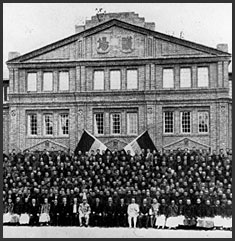|
 |
 |
 |
 |
 |
| The Late Qing Outline |
 |
| When trying to understand the vision of how Chinese democracy would work, we might find it interesting to look at the constitutions. In the twentieth century, China has had a series of constitutions that provide, on paper, something of the vision of how democracy would work. The first constitution wasn't really a constitution. It was an outline for a constitution. In the last decade of the Qing dynasty (the last of the imperial dynasties), from 1900 to 1911, the Qing rulers got the idea that China might benefit if it made the transition to a constitutional monarchy. That would entail adopting a constitution, so in 1906 the imperial court published an outline for a future constitution. It basically said, in its first part, that the emperor possessed all powers. The outline did not limit the emperor much, but it was a big breakthrough just to write out nine or ten articles defining the emperor's power. The Qing rulers were trying to model themselves on a Western constitutional monarchy. The second part of the outline showed a vision of the people and the emperor together. It said that the people had the right to petition the emperor for judgments. The people could elect assemblies that would advise and consult with the emperor. |
 |
| Republican Constitutions |
 |
 |
 |
 |
 |
| The Chinese parliament, 1916. |
 |
| Hulton|Archive by Getty Images |
|
The dynasty fell in 1911 and the Chinese Republic was established in 1912, lasting until 1949. The republic had several constitutions. There was one in 1912, another in 1923, and so on. They tended to have a couple of important common elements. They all called for elected parliaments, whose members would be elected by a limited franchise and, in later editions, by a universal franchise. It was envisioned that the collective wisdom of the people would be represented in the parliament, thereby strengthening the state. The various constitutions did not pit the parliament against any other branch of government. All of the constitutions included a section on citizens' rights: freedom of speech, freedom of assembly, the right to vote, the right to run for office—all the elements you would expect from any other government constitution. The Chinese constitutions, though, always included a provision that these rights would be provided as determined by law, or that they could not be limited except as provided by law. In the end, the concept of individual rights represented in these constitutions is very different from, say, the American notion of rights as a limit on the law—that the law cannot go beyond these rights, that the rights precede the law. The law came along afterward, and could deal with anything until it collided with rights. The Chinese tradition is quite different. It's that the law comes along and generates rights. Why would you have that idea of rights? It's because of the idea of the unity of government and citizens, that they have so many interests in common that the government will give citizens the rights they ought to have. They will exercise those rights in the spirit that would serve the needs of the larger society. So the notion that citizens might have rights that would set them against the society, and that they need those rights especially when they find themselves opposed to it—in the Chinese notion of rights, that doesn't quite compute. |
 |
|
 |
  |
 |
|






